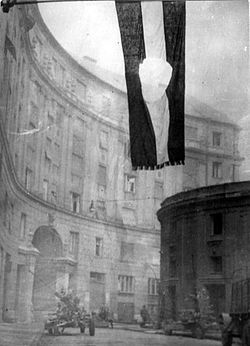Double remembrance
There are three national holidays in Hungary. October 23 commemorates two key events in the history of Hungary. First of all, on 23 October of 1956, Hungarians rose up against the Soviet ruled communist system. The Republic of Hungary was born 33 years later. How is the story of the Hungarian Flag with a Hole is related to these historical milestones?
Little history and the Hungarian flag
The Soviet Union occupied Hungary after WWII. Consequently, the Soviet backed Hungarian communists won the elections. In addition, the Soviet Union soon placed a new flag replacing the millenia-old Hungarian symbols with the Soviet-style communist red star and hammer. The first acts of resistance in the Soviet bloc were the protests in East Germany in 1953. Three years later strikes and street protests followed in Poznań, Poland.
The uprising began as a rally in central Budapest, to express solidarity with Polish demonstrators. The gathering turned into a mass demonstration for a similar Hungarian ‘declaration of independence’ from Moscow’s control. Hence, one of the first acts of defiance by Hungarian Freedom Fighters in 1956 was to tear out the communist symbols, leaving a ‘Hole in the Flag’. Therefore, the Flag with the Hole is one of the most indelible images of the 1956 Revolution and today stands as a powerful symbol for freedom.

The repression of the Revolution
On this day peaceful protests calling for free elections and a free press (among other things) started what would become a weeks-long bloody freedom fight in which thousands would die. The Soviets attacked on November 4th and the Hungarians fought bravely but were defeated and crushed. The Hungarians maintained their resistance until November 10th of that year, but then the government fell. By the end of that time over 2,500 Hungarians and 700 Soviet troops were killed and 200,000 Hungarians fled as refugees. The conflict continued for months after with many mass arrests and denunciations. Once the Soviets installed their government they suppressed all public opposition for over 30 years until the 1980’s.

October 23, 1956, is a day that will live forever in the annals of free men and nations. It was a day of courage, conscience and triumph. No other day since history began has shown more clearly the eternal unquenchability of man’s desire to be free, whatever the odds against success, whatever the sacrifice required. – John F. Kennedy, on the first anniversary of the Hungarian Revolution.
October 23 programs in Budapest this year.
All images are from Pinterest.
